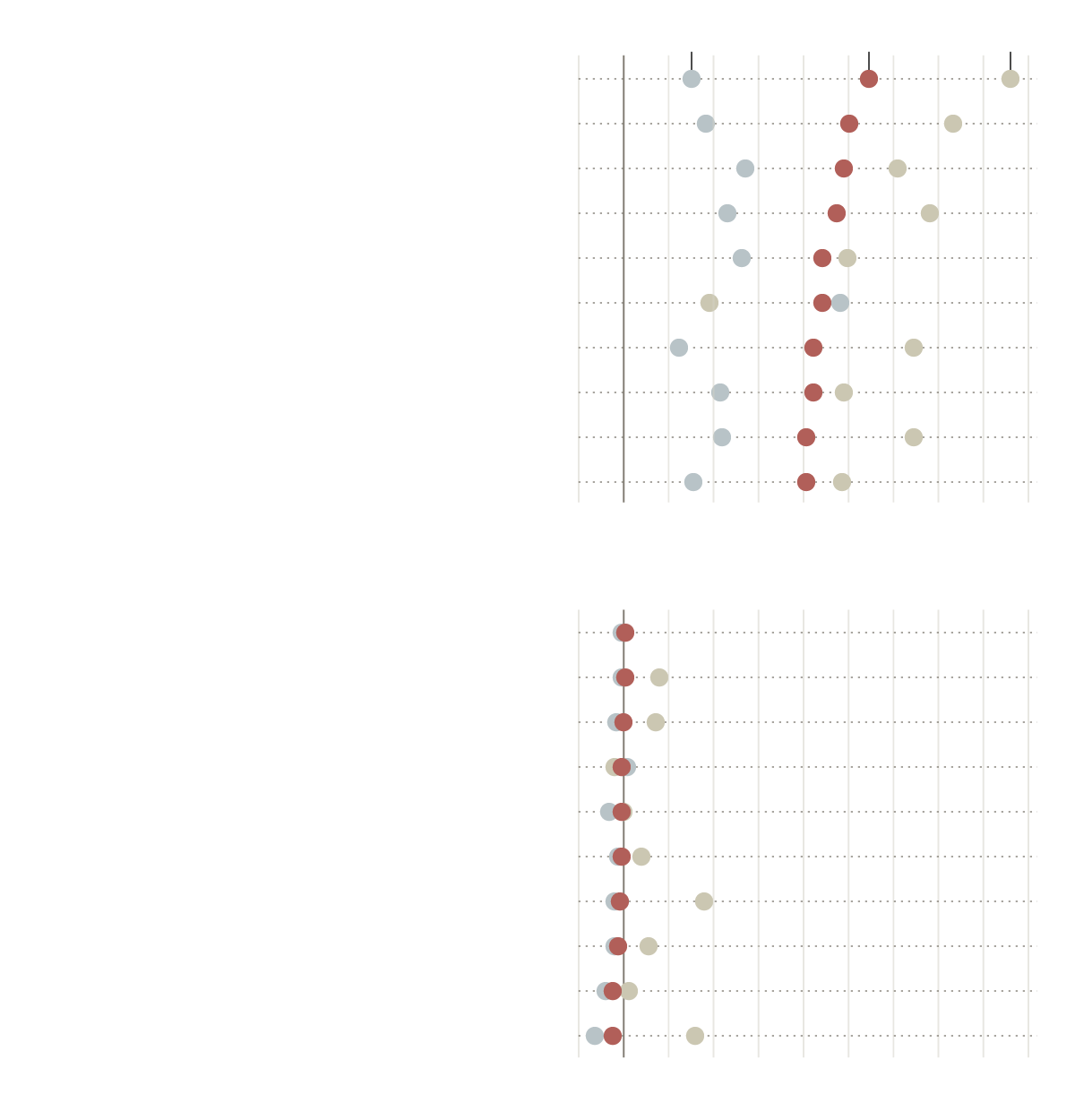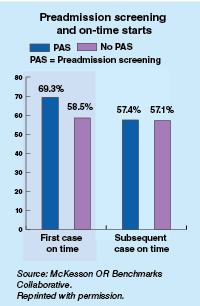Home » Uncategorized (Page 5)
Category Archives: Uncategorized
Benchmark Comparisons
Benchmarks provide context, allows for assessment of performance, helps identify outliers within data and can be used to set goals and targets. Decision-making benefits, more informed choices, performance improvements and communication become effective with benchmark comparisons. There is quality assurance, allows for competitive analysis and even assessing effectiveness with programs and policy. You are able to conclude with meaningful insights. The example below is from NY Times and the Net Promoter Score for Top Brands. It’s a simple bar graph with minimal color. Net Promotor Score (NPS) is a customer loyalty metric that measures a customer’s willingness to return for another purchase/service but make recommendations as well. This can increase a company’s revenue. Scores higher than 0 are typically good and above 50 is excellent. The bar graph has list of companies on the y-axis with the scores on the x-axis

Benchmark Comparisons
Data visualizations often are made through comparison of values and the best way to do that is to include a reference point to evaluate data. Based on where the benchmark is located the viewer can analyze if it is above or below that point. This can help provide context to the data or it can be used to mark goals in data. In data visualization, it is important to have these indicators so that the information being presented has meaning.

The data above was pulled from an article uploaded to The New York Times called, “Where’s All the Antarctic Sea Ice? Annual Peak Is the Lowest Ever Recorded” by Delger Erdenesanaa and Leanne Abraham. The authors report that the annual peak of Antarctic sea ice has reached its lowest recorded levels. This decline in sea ice extent raises concerns about the implications of climate change for the polar region. What they did to visualize this data was to add in a “benchmark” shown as the dotted line to represent the average from 1979-2010. You can clearly see that where we are in 2023 (shown in red) that the Antarctic sea ice drops below the benchmark by an extensive amount. Based on the data shown, they are able to assess where the level should be and can make the achievement goal to be above that targeted area. https://www.nytimes.com/2023/10/04/climate/antarctic-sea-ice-record-low.html
Benchmarking Graphs
Benchmarking your data visualizations is an excellent way to convey an important
factor in your graphs, what the numbers should look like, and how they fare
in comparison to that number. Helpful in showing outliers like how something is over-
or under-performing, or showing how perfect fit a value is towards some specified goal
benchmarks are a powerful tool that can be added to most graphs.
To show you an example, the following graph tracks goods and services pre-
and post-pandemic.

https://www.nytimes.com/2023/07/27/business/economy/us-economy-gdp-q2.html
It is easy to see the strengths of the trend lines as a way to measure the expected
values for the services and goods and how they compare to the trendlines before and
after the pandemic.
The following graph makes use of a perfectly horizontal benchmark line. This makes
reading the graph even easier than trend lines as being able to reference the single
value of the benchmark reduces user effort.

https://www.nytimes.com/2023/06/08/business/economy/us-economy-inflation-fed.html
The anomaly of the employment boom following the pandemic is immediately apparent with this example, highlighting the clarity that benchmarking provides.
Finally, this benchmark is just an average of the values in the graph. While not as
easy to interpret as the other methods, this one is a near-universal improvement that
can be made to any graph.
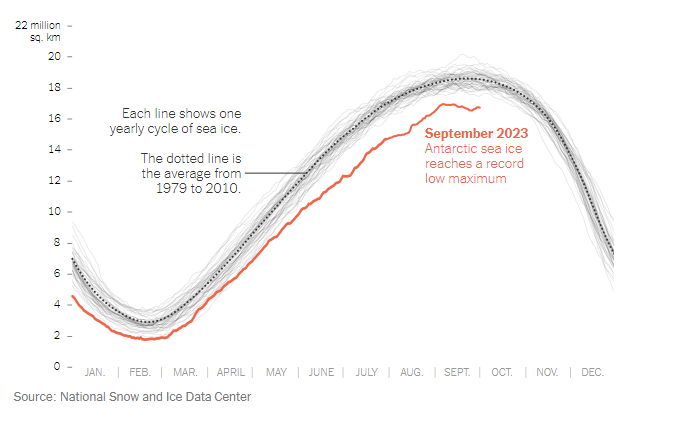
https://www.nytimes.com/2023/10/04/climate/antarctic-sea-ice-record-low.html?searchResultPosition=4
Benchmark Comparisons
By Ryan Metch
Using visualizations such as benchmark graphs allows us to better understand different types of data. The definition of a benchmark graph according to google is a visual tool that shows how fractions compare to a whole on a number line. Going off this graph from the Wall Street Journal, we can see how prices of European and American oil compare to one another. We can clearly see when changes occur on this graph, which is why a benchmark graph is a great tool to display this type of data.

Benchmark Comparisons
Benchmarks are an incredibly fast and effective way to provide a significant amount of context to a graphical display of information. This can be done in many ways, such as with a line or single symbol indicator. Benchmarks are most often used in financial matters; however, they still may prove useful for other purposes. In financial context, evaluating benchmarks may allow for insight into shifts in business over time. Whereas establishing benchmarks can allow businesses to more accurately gauge the performance of their employees as well as provide some motivation for progress.
In a New York Times article written by Clifford Krauss, he covers the significance of the dropping fuel demand in relation to how this affects oil suppliers.

In the graph above, there is a clear trend of a dip in crude oil prices in the U.S. over the course of a little over a year. The benchmark of concern that was mentioned in the article, is $80 per barrel of crude oil. In a bold attempt to increase oil prices by cutting production, Saudia Arabia may have inadvertently caused the opposite effect to occur. Allies of the OPEC Plus cartel (Saudia Arabia included) have shown concern over this value remaining at or below $80 per barrel of crude oil. I feel as if the significance of this value may be better illustrated by highlighting this lines value differently than the others.
Benchmark Comparisons
Infographic as a whole usually display information such as sales on year by year comparison. However, these type of graphics can come in handy when looking at a benchmark. I am taking an example from National Oceanic and Atmospheric Administration’s website and few other regarding the global temperature

This first graph here is a “Yearly surface temperature compared to the 20th-century average from 1880–2022” and blue bars indicate cooler-than-average years; red bars show warmer-than-average years. One thing can be seen from this type of graph is how you can easily see how much of a difference between years. The graph only listed from -1.0 to 1.0 Celcius (30.8 to 33.8 Fahrenheit) but the short distance between the maximum and the minimum y-axis makes a small difference much more exaggerated. At first, I would have like to know the actual average temperature on a yearly basis but this would not fit in this type of graph due to the amount of spaces needed for additional data.

This graph is a similar graph comparing temperature from NASA’s website. This offer one more variable to look at is the LOWESS smoothing. By definition from NOAA’s website, LOWESS or LOESS is a nonparametric method for smoothing a series of data in which no assumptions are made about the underlying structure of the data and is effective when there are outliers in the data. However it is difficult to understand any of the scientific terms but overall just another example on how current temperature can be shown on a graph.

This graph here is “Projected Temperature Increase (°C)” from Center for Science Education. This graph is benchmarking the future temperature on a few different scenarios as listed within the graph itself. Black line and grey area perhaps are the accepted temperature change by many scientists. This graph is definitely great in comparison and it shows the temperature entirely depends on the decisions of humans. However what is missing here that makes me wonder is what is the different between CO2 amount from each scenarios such as would the highest CO2 be somewhat for an example 10 million and medium to high would be somewhere 3 million to 5 million and so on. Overall, it may seem that the actual number of CO2 because it is not the main focus of this graph.
Benchmark Comparisons
When I look at data one of the most important concepts for me is relativity. What does that data mean relative to other data? When we look at relative data, we begin to really see the story of that data in the context that defines it. Benchmarking is a standard or point of reference by which data can be compared. Benchmarks represent a significant portion of data representation in many fields and can assist in the application of productivity concepts such as performance and service.
One of the most common benchmarks that we see often is financial benchmarks, specifically related to the stock market. People go to many different news sources to check on their investments but you will see charts that look very similar on every site. This graph shows the performance of Home Depot stock in the past year.

https://www.wsj.com/market-data/quotes/hd
This graph shows the performance of Home Depot stock compared to the benchmark set by the S&P 500:

https://www.wsj.com/market-data/quotes/hd
While HD is up 2.99% in the past year, it is not doing great when compared to the benchmark performance of the S&P 500, which is up 18.99%.
A New York Times article exploring the effects of pandemic school closures on the math scores of students showed some interesting results. In 2019 there was a distinct pattern between the students in wealthier districts scoring above average on math tests.


In 2012 there was a shift in all scores across the board. This change happened amongst all income levels and racial groups.

I enjoyed this article and the benchmarks showed that even though the researchers did not find the results that they had expected, they presented the data because it was quite remarkable. They had assumed that the children in poorer districts and minorities would have been even further behind benchmarks but the data showed otherwise. When data is presented that is the opposite of initial assumptions I find it more interesting because it shows the importance of data science and visualization. Without data we are left with assumptions…which are sorely lacking.
Benchmark Analysis
In today’s world, many data charts have been used in the market economy and small businesses. This blog is about benchmark graphs and how they allow you to identify improvement areas to get the company on par with growth and success. With the help of a benchmark graph, it allows businesses to compare their performance against competitors. In addition, it gives strategic decision-making ideas by analyzing the performance of competitors. The benchmark graph is innovative in comparison with a regular bar graph. This blog, it’s all about “The Employment Situation in January” The number of jobs added in January came in well above market expectations after unemployment from 2020. Based on the report from the U.S. Bureau of Labor Statistics the unemployment rate ticked up by 0.1 percentage point to 4.0 percent.
Average monthly job growth over the last three months was 541,000 a fast pace.
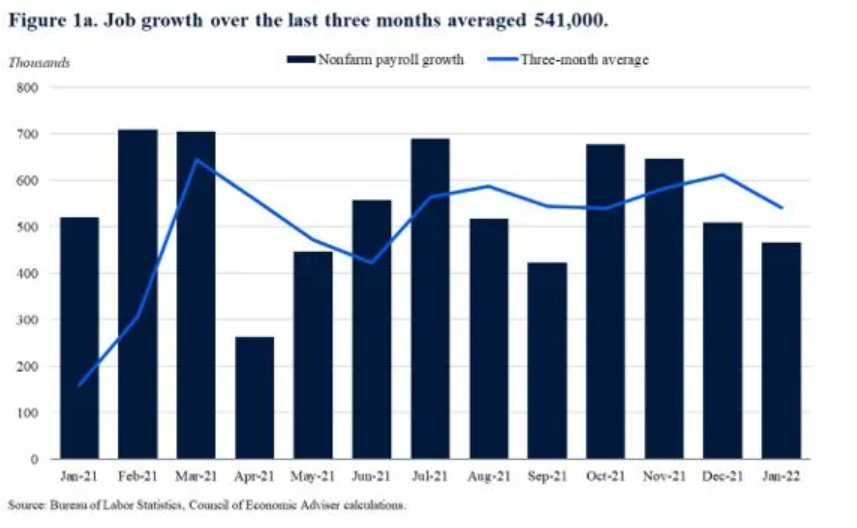
In this graph, the target line is a three-month average, and the bar graph represents nonfarm payroll growth. Since monthly numbers can be volatile and subject to revision, the Council of Economic Advisers prefers to focus on the three-month average rather than the data in a single month. This graph is the perfect example of good benchmark analysis since some bar column is above the target line which means there is growth in the number of jobs.
Labor force participation grew by 0.8% point year-over-year, a fast pace.
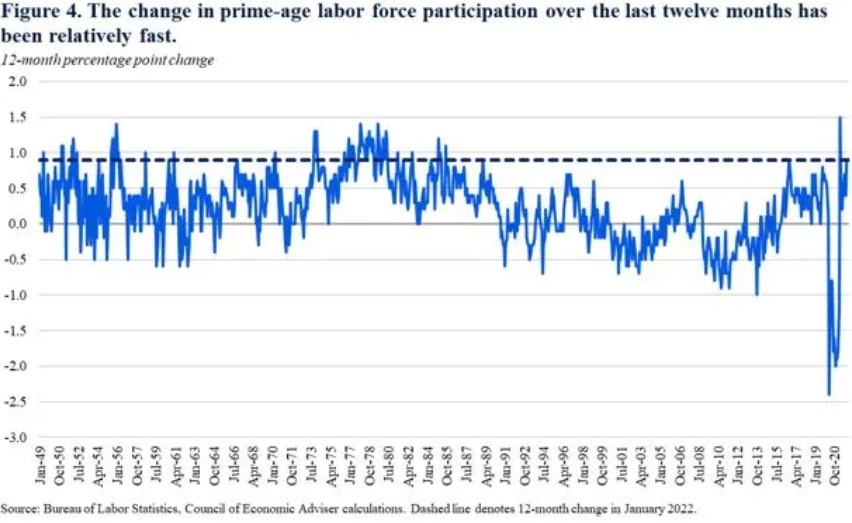
The above graph is an example of labor force participation. According to the Bureau of Labor Statistics, the labor force participation rate was 62.2% in January, up from 61.4% percent a year ago. The “prime age” (25 to 54) labor force participation rate was 82% up from 81.1% percent a year ago. The Council of Economic Advisers prefers the participation rate because it is less impacted by changes in educational enrollment and the natural slowdown in labor force participation caused by the aging of the population and retirements. As we can see in the graph back in the day the labor force was above the target line and it got below the line from the year 1990 till 2020.
Overall, a Benchmark graph is a powerful tool in data visualization for businesses and other organizations to gain better performance, tracking data, and identify areas for improvement and development. This activity cleared a concept of mine towards benchmarking and how it is used at a bigger stage. Getting the knowledge of this graph will help me in every sector of economic fields.
Reference
https://www.whitehouse.gov/cea/written-materials/2022/02/04/the-employment-situation-in-january-2/
Benchmark Analyses
By using infographic tools, benchmark analyses are presented in a variety of visual formats. In accordance with the Robert Wood Johnson Foundation’s considerations for selecting a benchmark for health equity. In other words, benchmarking can be used to evaluate health gaps and assess the quality of care to address these disparities. There are advantages and disadvantages when using different approaches to benchmarking health equity. It was concluded that there was no bet method for selecting a benchmark for health equity assessment.
Examining the results of the RAND study reveals how much hospitals are charging private insurers. Two scatter plots are used in New York Times article, to illustrate the most and least expensive hospitals for private insurers, compared to Medicare. In the first scatter plot, the most expensive hospitals are displayed, while in the second plot, the least expensive hospitals are displayed. Among the benchmarks was Michigan, where private sectors are about two and a half times those charged my Medicare. Further details about how prices vary greatly
This is powerful distinction that RAND made to conclude that market forces are not working. This is always important to know and understand, since this involves financial income and it’s everyone’s right to know when they have been taken advantage of. The ability to see these data numerics visually makes all the difference.
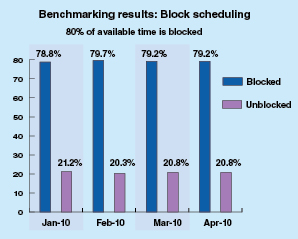

As another example of an infographic benchmark, the ormanager analyst offers benchmarks based on actual data from the sample of hospitals displayed. Comparisons are between two bar and 1 pie charts. As a result these correlations, they can differentiate between hospital productivity, hospital factors, like country (US or Canada), building type, and number of operating rooms. It was found that on average, US hospitals had lower scheduling quality than their Canadian counterparts. The turnaround time for US facilities was 15 minutes longer than expected compared to Canadian facilities.
Final Thoughts
As a result of my research, I have gained a in-depth understanding of infographic benchmark and the many domains and employment that they can be applied to in order to assist with the comparison of analytical data displayed in graphs. These tools have further piqued my interest and I would like to see more visual infographic comparisons in my own research fields and use them to make distinctions and not differences in future research papers.
Benchmark’s in Data
Many different types of data have an underlying benchmark included. A benchmark put simply is just a target or a goal that the organizer wants to meet or exceed. I have worked for multiple organizations who set these goals on a monthly or quarterly level then looked back over them to make predictions for the future. There are multiple different ways we can use benchmarks to visualize our achievements. We will take a look at some of these different visuals and see which ones work the best to portray a message.
The Benchmark Bar Graph

In a bar graph we can compare a value over time very easily but with the addition of a benchmark line we can see which time periods performed the best. Sometimes pure quantity doesn’t tell a whole story. Some months can see higher sales year after year. If we put a benchmark line in that month it is easier to see how it is really performing. This idea is highlighted in the above chart, the 20 year sales have exceeded goals by 2% which is great but as we get closer to the 2 year mark we see a miss of the goal yet a higher total sales. The 2 year mark obviously has a higher target to meet based on history and other factors. Growing benchmarks must mean the company is growing because they are achieving more and more goals.
Benchmark Line Graph

Here we see a different type of measuring a benchmark over time. The benchmark line here is the green portion and we can observe either exceeding expectations or shortcomings based on the blue line above. The benchmark is set steady at 18% and does not change. This means their goals do not change based on history or trends. Without changing goals how would this example grow. If we are trying to meet goals that always stay the same we’ll never see long term growth. Pushing goals up and up based on success will lead to meeting higher goals and higher growth.
Comparing Multiple Line Graphs

Here we have a graph of the emerging markets and how they stack up against the rest of the world. It measures total manufacturing output over the last 17 years. After a quick glance you don’t come away with much of an impression, this is due to a closely overlapping graph. I think this is a useful graph but it takes some time to really make a judgement on since the two lines are so closely related. I think it would be of more use if we saw it on a monthly level to really get some separation to see where the emerging markets are exceeding the world.
I think after all of these visuals we can understand what a benchmark really consists of. We also saw multiple different uses of them and can probably choose a favorite. I think the easiest one to read was the bar graph with clear benchmark lines that made it clear what points fell where in comparison with the benchmark.
